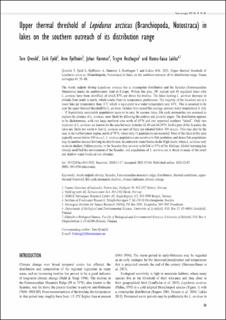| dc.contributor.author | Qvenild, Tore | |
| dc.contributor.author | Fjeld, Eirik | |
| dc.contributor.author | Fjellheim, Arne | |
| dc.contributor.author | Hammar, Johan | |
| dc.contributor.author | Hesthagen, Trygve H. | |
| dc.contributor.author | Lakka, Hanna-Kaisa | |
| dc.date.accessioned | 2021-12-13T11:47:16Z | |
| dc.date.available | 2021-12-13T11:47:16Z | |
| dc.date.created | 2021-12-10T14:46:35Z | |
| dc.date.issued | 2021 | |
| dc.identifier.citation | Fauna Norvegica. 2021, 41 50-88. | en_US |
| dc.identifier.issn | 1502-4873 | |
| dc.identifier.uri | https://hdl.handle.net/11250/2833975 | |
| dc.description.abstract | The Arctic tadpole shrimp Lepidurus arcticus has a circumpolar distribution and the Scandes (Fennoscandian Mountains) marks its southernmost limit in Europe. Within this area, 391 natural and 88 regulated lakes with L. arcticus have been identified, of which 87% are above the treeline. The lakes hosting L. arcticus decrease in altitude from south to north, which results from its temperature preferences. The majority of the locations are at a lower lake air temperature than 11°C which is equivalent to a water temperature near 14°C. This is assumed to be near the upper thermal threshold for L. arcticus. In lakes that exceed this average summer water temperature (1 July – 15 September), sustainable populations seem to be rare. In warmer lakes, life cycle mismatches are assumed to explain the absence of L. arcticus, most likely by affecting the embryo and juvenile stages. The distribution appears to be dichotomous, with one large northern area north of 65°N and one separated southern “island”. Only two locations of L. arcticus are known for the area between latitudes 62.88 and 64.39°N. In this part of the Scandes, the lakes are likely too warm to host L. arcticus as most of them are situated below 700 m a.s.l. This may also be the case in the northernmost region, north of 70°N, where only 11 populations are recorded. Most of the lakes in this area typically occurs below 400 m a.s.l. L. arcticus populations are sensitive to fish predation, and dense fish populations may be another stressor limiting its distribution. In contrast to water bodies in the High Arctic where L. arcticus only exists in shallow, fishless ponds, in the Scandes they co-exist with fish in 97% of the findings. Global warming has already modified the environment of the Scandes, and populations of L. arcticus are at threat in many of the small and shallow water bodies at low altitudes. | en_US |
| dc.language.iso | eng | en_US |
| dc.rights | Navngivelse 4.0 Internasjonal | * |
| dc.rights.uri | http://creativecommons.org/licenses/by/4.0/deed.no | * |
| dc.title | Upper thermal threshold of Lepidurus arcticus (Branchiopoda, Notostraca) in lakes on the southern outreach of its distribution range | en_US |
| dc.type | Journal article | en_US |
| dc.type | Peer reviewed | en_US |
| dc.description.version | publishedVersion | en_US |
| cristin.ispublished | true | |
| cristin.fulltext | original | |
| cristin.qualitycode | 1 | |
| dc.identifier.doi | 10.5324/fn.v41i0.3832 | |
| dc.identifier.cristin | 1967153 | |
| dc.source.journal | Fauna Norvegica | en_US |
| dc.source.volume | 41 | en_US |
| dc.source.pagenumber | 50-88 | en_US |
| dc.subject.nsi | VDP::Zoologiske og botaniske fag: 480 | en_US |
| dc.subject.nsi | VDP::Zoology and botany: 480 | en_US |

